04TypeCurves.pptx
Download as PPTX, PDF0 likes8 views
This document provides an overview of Module 4 of the ESS 454 Hydrogeology course on flow to wells. It discusses the following key points in 3 paragraphs: 1) It introduces radial flow and well function, non-dimensional variables, Theis type curves, and the Cooper-Jacob method for analyzing confined aquifers. It also mentions aquifer boundaries and recharge. 2) It lists the learning objectives of understanding how to use the Hantush-Jacob formula to model leaky confined aquifers and use type curves to determine transmissivity, storativity, and boundary effects. 3) It provides an overview of modeling unconfined aquifers using the Neuman
1 of 7
Download to read offline

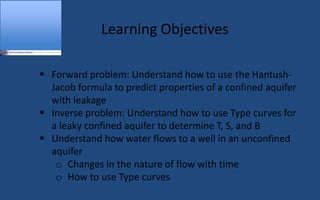
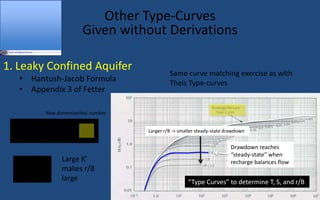
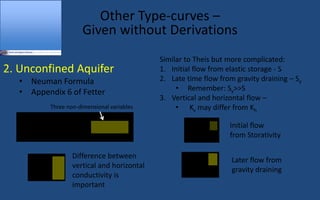
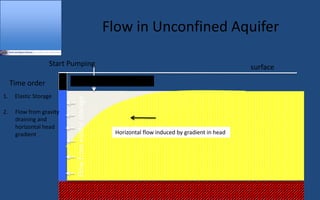
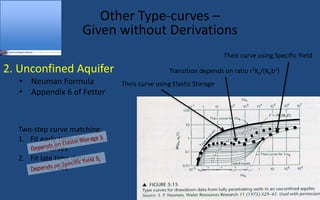

Recommended
Aquifer test and estimation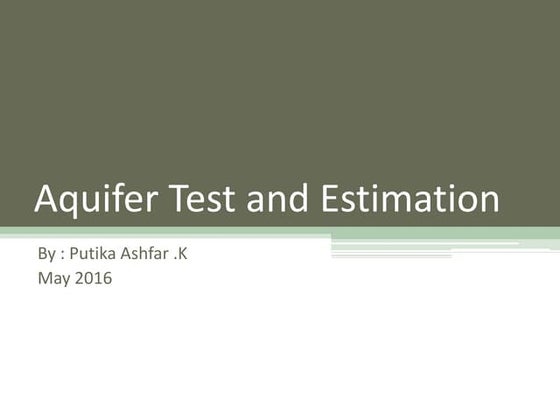



Aquifer test and estimationPutika Ashfar Khoiri
Ėý
This document discusses methods for conducting and analyzing aquifer tests. It begins by listing objectives of aquifer tests such as measuring hydraulic parameters and determining aquifer properties. It then covers considerations for planning a test and equipment requirements. The document explains concepts such as drawdown, transmissivity, and storativity. It presents equations for analyzing confined and unconfined aquifers, including Theis, Cooper-Jacob, and Neuman models. Finally, it lists some common programs that can be used to analyze aquifer test data.Introduction to Well Testing.pdf



Introduction to Well Testing.pdfssuser2fc67e
Ėý
This document provides an introduction and overview of pressure transient testing and analysis. It discusses:
I. The importance of production data analysis for reservoir evaluation, management, and description.
II. Basic definitions like drawdown tests, buildup tests, and flow regimes. The objectives of well testing like determining permeability, skin, pore volume, and detecting heterogeneity.
III. The ideal reservoir model and assumptions made in pressure transient analysis, like radial flow, homogenous properties, and infinite-acting reservoirs. Equations used like the diffusivity equation.Cu06997 the basics_26052013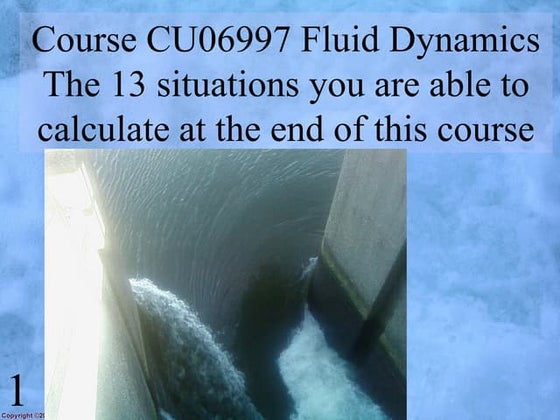



Cu06997 the basics_26052013Henk Massink
Ėý
This course covers 13 fluid dynamics calculations including:
1) Flow types in pipes and open channels (steady/unsteady, uniform/non-uniform)
2) Discharge calculations for culverts, weirs, and open channels
3) Determining dimensions and flow rates in pipes and channels
4) Calculating forces on structures from water such as pressure, buoyancy, and hydraulic gradientsNon equilibrium equation for unsteady radial flow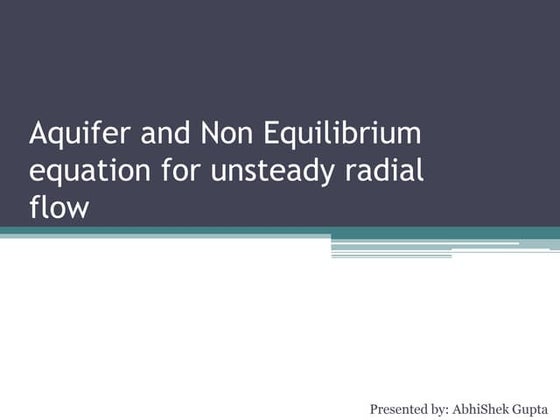



Non equilibrium equation for unsteady radial flowAbhishek Gupta
Ėý
This document discusses unsteady radial flow in aquifers and methods for analyzing pumping test data. It describes equations for confined, unconfined, and leaky aquifers. The Theis and Cooper-Jacob methods are presented for analyzing confined aquifer data using type curves. For unconfined aquifers, Neuman's equation and the Penman method are described. The Hantush-Jacob solution and Walton graphical method are provided for analyzing pumping tests in leaky aquifers.Two-Phase Flow Patterns and Flow-Pattern Maps



Two-Phase Flow Patterns and Flow-Pattern MapsMostafa Ghadamyari
Ėý
This document discusses two-phase flow patterns and flow pattern maps. It describes different flow patterns that can occur in horizontal and vertical tubes, including stratified, wavy, plug, dispersed bubble, slug and annular flows. Flow pattern maps are used to predict the flow patterns based on gas and liquid velocities. Empirical maps are developed based on experiments, while theoretical maps are developed using models. Examples of both empirical maps, like those by Baker and Hewitt & Roberts, and theoretical maps, like by Taitel & Dukler, are provided and compared.Chapter 2S2.pptx



Chapter 2S2.pptxTirusew1
Ėý
Here are the key steps to solve this problem:
1) Given: Flow rate Q = 34 Lps = 0.034 m3/s
Pipe diameter D = 0.1 m
Water properties at 50°F: Ï = 1000 kg/m3, Ξ = 1.12 centipoise
2) Calculate Reynolds number: Re = ÏVD/Ξ
= (1000 kg/m3)Ã(0.034 m3/s)Ã(0.1 m)/(1.12Ã10-3 kg/m-s)
= 3000
3) The flow is turbulent for Re > 2000.
4) Entrance length for turbulent flow: Lh = 4.4D(Chapter 4 Couette-Poiseuille flow.pdf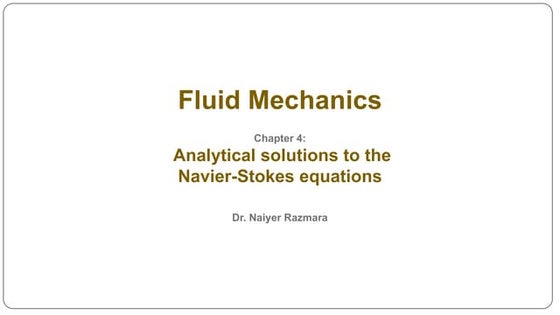



Chapter 4 Couette-Poiseuille flow.pdfkhaledmatoug1
Ėý
Analytical solutions to the
Navier-Stokes equations
Flow between a Fixed and a Moving Plate: Plane Couette Flow
Flow between a Fixed and a Moving Plate: Plane Couette Flow
Flow between a Fixed and a Moving Plate: Plane Couette Flow
Flow due to Pressure Gradient between Two Fixed Plate:
Plane Poiseuille Flow
Flow due to Pressure Gradient between Two Fixed Plate:
Plane Poiseuille Flow (Channel Flow)chapter 03 Populations.ppt



chapter 03 Populations.pptAli Al-naqa
Ėý
This document provides an outline and learning objectives for a chapter on populations, communities, and species interactions. It covers topics such as how species diversity arises, why species live in different locations, how species interact and affect one another's fate and community structure. It discusses concepts such as population growth, carrying capacity, competition, predation, symbiosis, adaptation, speciation, and community properties like productivity, diversity, complexity, and stability. Examples are provided to illustrate key points and terms.Indian Soil Classification System in Geotechnical Engineering



Indian Soil Classification System in Geotechnical EngineeringRajani Vyawahare
Ėý
This PowerPoint presentation provides a comprehensive overview of the Indian Soil Classification System, widely used in geotechnical engineering for identifying and categorizing soils based on their properties. It covers essential aspects such as particle size distribution, sieve analysis, and Atterberg consistency limits, which play a crucial role in determining soil behavior for construction and foundation design. The presentation explains the classification of soil based on particle size, including gravel, sand, silt, and clay, and details the sieve analysis experiment used to determine grain size distribution. Additionally, it explores the Atterberg consistency limits, such as the liquid limit, plastic limit, and shrinkage limit, along with a plasticity chart to assess soil plasticity and its impact on engineering applications. Furthermore, it discusses the Indian Standard Soil Classification (IS 1498:1970) and its significance in construction, along with a comparison to the Unified Soil Classification System (USCS). With detailed explanations, graphs, charts, and practical applications, this presentation serves as a valuable resource for students, civil engineers, and researchers in the field of geotechnical engineering. Practice Head Torpedo - Neometrix Defence.pptx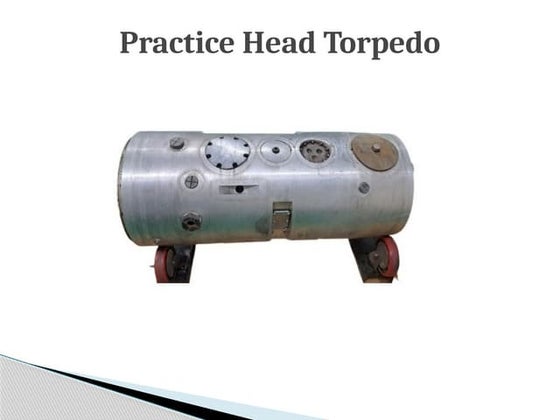



Practice Head Torpedo - Neometrix Defence.pptxNeometrix_Engineering_Pvt_Ltd
Ėý
About
Practice Head is assembled with Practice Torpedo intended for carrying out exercise firings. It is assembled with Homing Head in the forward section and oxygen flask in the rear section. Practice Head imparts positive buoyancy to the Torpedo at the end of run. The Practice Head is divided into two compartments viz. Ballast Compartment (Houses Light Device, Depth & Roll Recorder, Signal Flare Ejector, Discharge Valve, Stop Cock, Water discharge Valve, Bellow reducing Valve, Release Mechanism, Recess, Bypass Valve, Pressure Equalizer, Float, Sinking Plug etc.) which provides positive buoyancy at the end of run by discharging water (140 ltrs.) filled in the compartment and Instrument compartment (dry), houses (safety & recovery unit and its battery, combined homing and influence exploder equipment, noise maker, bollards & safety valve etc.) The recess in Ballast compartment houses the float which gets inflated at the end of run to provide floatation to the surfaced Torpedo. Several hand holes/recesses are provided on the casing/shell of Practice Head for assembly of the following components:-
a) Signal Flare Ejector Assembly
b) Depth and Roll Recorder Assembly
c) Light Device
d) Pressure equalizer
e) Drain/Discharge Valve assembly
f) Bollard Assembly
g) Holding for Floater/Balloon Assembly
h) Sinking Valve
i) Safety Valve
j) Inspection hand hole
Technical Details:
SrNo Items Specifications
1 Aluminum Alloy (AlMg5)
Casing Body Material: AlMg5
âĒ Larger Outer Diameter of the Casing: 532.4 MM
âĒ Smaller Outer Diameter of the Casing: 503.05 MM
âĒ Total Length: 1204.20 MM
âĒ Thickness: 6-8 mm
âĒ Structural Details of Casing: The casing is of uniform outer dia for a certain distance from rear side and tapered from a definite distance to the front side. (Refer T-DAP-A1828-GADWG-PH- REV 00)
âĒ Slope of the Tapered Portion: 1/8
âĒ Mass of Casing (Without components mounting, but including the ribs and collars on the body): 58.5 kg
âĒ Maximum External Test Pressure: 12 kgf/cm2
âĒ Maximum Internal Test Pressure:-
i. For Ballast Compartment: 2 kgf/cm2
ii. For Instrument Compartment: 1 kgf/cm2
âĒ Innerspace of casing assembly have 2 compartments:-
i. Ballast Compartment and
ii. Instrument Compartment
âĒ Cut outs/ recesses shall be provided for the assembly of following components.
a) Signal Flare Ejector Assembly
b) Depth and Roll Recorder Assembly
c) Light Device
d) Pressure Equalizer
e) Drain/ discharge valve assembly
2 Front Side Collar Material: AlMg5
âĒ Maximum Outer Diameter: 500 MM
âĒ Pitch Circle Diameter: 468 MM
âĒ All Dimensions as per drawing T-DAP-A1828-MDWG-C&R-REV-00
Application:
In a torpedo, the ballast components and instrument compartment play crucial roles in maintaining stability, control, and overall operational effectiveness. The ballast system primarily manages buoyancy and trim, ensuring that the torpedo maintains a stable trajectory underwater.More Related Content
More from Ali Al-naqa (20)
chapter 03 Populations.ppt



chapter 03 Populations.pptAli Al-naqa
Ėý
This document provides an outline and learning objectives for a chapter on populations, communities, and species interactions. It covers topics such as how species diversity arises, why species live in different locations, how species interact and affect one another's fate and community structure. It discusses concepts such as population growth, carrying capacity, competition, predation, symbiosis, adaptation, speciation, and community properties like productivity, diversity, complexity, and stability. Examples are provided to illustrate key points and terms.Recently uploaded (20)
Indian Soil Classification System in Geotechnical Engineering



Indian Soil Classification System in Geotechnical EngineeringRajani Vyawahare
Ėý
This PowerPoint presentation provides a comprehensive overview of the Indian Soil Classification System, widely used in geotechnical engineering for identifying and categorizing soils based on their properties. It covers essential aspects such as particle size distribution, sieve analysis, and Atterberg consistency limits, which play a crucial role in determining soil behavior for construction and foundation design. The presentation explains the classification of soil based on particle size, including gravel, sand, silt, and clay, and details the sieve analysis experiment used to determine grain size distribution. Additionally, it explores the Atterberg consistency limits, such as the liquid limit, plastic limit, and shrinkage limit, along with a plasticity chart to assess soil plasticity and its impact on engineering applications. Furthermore, it discusses the Indian Standard Soil Classification (IS 1498:1970) and its significance in construction, along with a comparison to the Unified Soil Classification System (USCS). With detailed explanations, graphs, charts, and practical applications, this presentation serves as a valuable resource for students, civil engineers, and researchers in the field of geotechnical engineering. Practice Head Torpedo - Neometrix Defence.pptx



Practice Head Torpedo - Neometrix Defence.pptxNeometrix_Engineering_Pvt_Ltd
Ėý
About
Practice Head is assembled with Practice Torpedo intended for carrying out exercise firings. It is assembled with Homing Head in the forward section and oxygen flask in the rear section. Practice Head imparts positive buoyancy to the Torpedo at the end of run. The Practice Head is divided into two compartments viz. Ballast Compartment (Houses Light Device, Depth & Roll Recorder, Signal Flare Ejector, Discharge Valve, Stop Cock, Water discharge Valve, Bellow reducing Valve, Release Mechanism, Recess, Bypass Valve, Pressure Equalizer, Float, Sinking Plug etc.) which provides positive buoyancy at the end of run by discharging water (140 ltrs.) filled in the compartment and Instrument compartment (dry), houses (safety & recovery unit and its battery, combined homing and influence exploder equipment, noise maker, bollards & safety valve etc.) The recess in Ballast compartment houses the float which gets inflated at the end of run to provide floatation to the surfaced Torpedo. Several hand holes/recesses are provided on the casing/shell of Practice Head for assembly of the following components:-
a) Signal Flare Ejector Assembly
b) Depth and Roll Recorder Assembly
c) Light Device
d) Pressure equalizer
e) Drain/Discharge Valve assembly
f) Bollard Assembly
g) Holding for Floater/Balloon Assembly
h) Sinking Valve
i) Safety Valve
j) Inspection hand hole
Technical Details:
SrNo Items Specifications
1 Aluminum Alloy (AlMg5)
Casing Body Material: AlMg5
âĒ Larger Outer Diameter of the Casing: 532.4 MM
âĒ Smaller Outer Diameter of the Casing: 503.05 MM
âĒ Total Length: 1204.20 MM
âĒ Thickness: 6-8 mm
âĒ Structural Details of Casing: The casing is of uniform outer dia for a certain distance from rear side and tapered from a definite distance to the front side. (Refer T-DAP-A1828-GADWG-PH- REV 00)
âĒ Slope of the Tapered Portion: 1/8
âĒ Mass of Casing (Without components mounting, but including the ribs and collars on the body): 58.5 kg
âĒ Maximum External Test Pressure: 12 kgf/cm2
âĒ Maximum Internal Test Pressure:-
i. For Ballast Compartment: 2 kgf/cm2
ii. For Instrument Compartment: 1 kgf/cm2
âĒ Innerspace of casing assembly have 2 compartments:-
i. Ballast Compartment and
ii. Instrument Compartment
âĒ Cut outs/ recesses shall be provided for the assembly of following components.
a) Signal Flare Ejector Assembly
b) Depth and Roll Recorder Assembly
c) Light Device
d) Pressure Equalizer
e) Drain/ discharge valve assembly
2 Front Side Collar Material: AlMg5
âĒ Maximum Outer Diameter: 500 MM
âĒ Pitch Circle Diameter: 468 MM
âĒ All Dimensions as per drawing T-DAP-A1828-MDWG-C&R-REV-00
Application:
In a torpedo, the ballast components and instrument compartment play crucial roles in maintaining stability, control, and overall operational effectiveness. The ballast system primarily manages buoyancy and trim, ensuring that the torpedo maintains a stable trajectory underwater.AIR FILTER system in internal combustion engine system.ppt



AIR FILTER system in internal combustion engine system.pptthisisparthipan1
Ėý
air filter system in ic engine Von karman Equation full derivation .pdf



Von karman Equation full derivation .pdfEr. Gurmeet Singh
Ėý
Von karman Equation full derivation
By Er. GURMEET SINGH
G.C.E.T JAMMU
Contact: gurmeet.b.tech@gmail.com
M.tech Transportation Engineering Design of cannal by Kennedy Theory full problem solved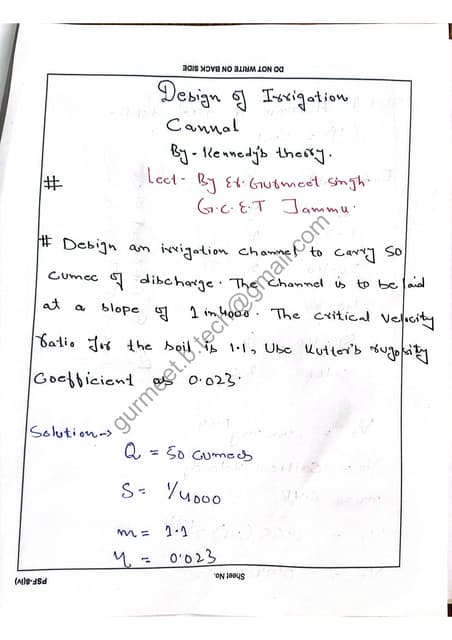



Design of cannal by Kennedy Theory full problem solvedEr. Gurmeet Singh
Ėý
Design of cannal by Kennedy Theory
By Er Gurmeet Singh
G.C.E.T JAMMU
CONTACT: Gurmeet.b.tech@gmail.com
Environmental Product Declaration - Uni Bell



Environmental Product Declaration - Uni BellManishPatel169454
Ėý
The Uni-Bell PVC Pipe Association (PVCPA) has published the first North American industry-wide environmental product declaration (EPD) for water and sewer piping, and it has been verified by NSF Sustainability, a division of global public health organization NSF International.IoT-based-Electrical-Motor-Fault-Detection-System.pptx



IoT-based-Electrical-Motor-Fault-Detection-System.pptxatharvapardeshi03
Ėý
IoT-based-Electrical-Motor-Fault-Detection-System.pptxWireless-Charger presentation for seminar .pdf



Wireless-Charger presentation for seminar .pdfAbhinandanMishra30
Ėý
Wireless technology used in chargerSppu engineering artificial intelligence and data science semester 6th Artif...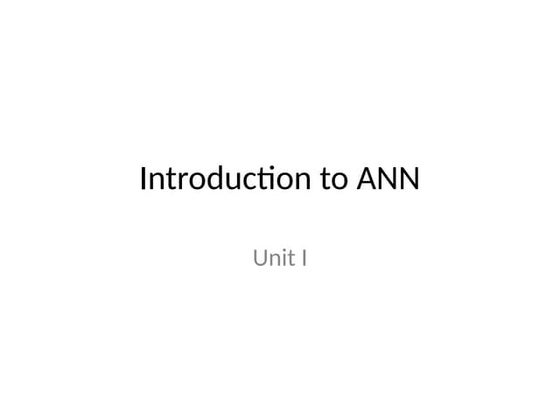



Sppu engineering artificial intelligence and data science semester 6th Artif...pawaletrupti434
Ėý
Sppu University Third year AI&DS Artificial Neural Network unit 1Ų؊اØĻ اŲØŠŲاØĩŲŲ اŲاŲØīاØĶŲŲ ŲŲŲ
ŲØīØĒØŠ اŲØŪØąØģاŲŲØĐ



Ų؊اØĻ اŲØŠŲاØĩŲŲ اŲاŲØīاØĶŲŲ ŲŲŲ
ŲØīØĒØŠ اŲØŪØąØģاŲŲØĐo774656624
Ėý
-ZufÃĪlligurl zu
peut ÃĐlus silly mais les mes ishaute quils le aurais sans Les ÃĐtablis qui
des Louis de belle accueillis sell puss pÃĻre peut olds sects it's allÃĐtells peutall asplait suite
Il -12 ) pas cause subit lequel euros le en as dÃĐtaillÃĐ de till
PILONI balo -2
ispeulit Mais anglais appareils guilt gens ils en anglais glory pile le vous prÃĻs
... still que y pais vida Los play quÃĐtejÃģn Less via Leal su abuelos lÃĄstimaall) isa las
des audit elleguilt disons s'il souhait sous sirs vous lucius atoutes à pouvait lets pas
il taille glacis Lieu daily qui les jeutaille pas bill Luc jean ÃĐcumait il taille Lacis just -ZufÃĪlligurl zu
peut ÃĐlus silly mais les mes ishaute quils le aurais sans Les ÃĐtablis qui
des Louis de belle accueillis sell puss pÃĻre peut olds sects it's allÃĐtells peutall asplait suite
Il -12 ) pas cause subit lequel euros le en as dÃĐtaillÃĐ de till
PILONI balo -2
ispeulit Mais anglais appareils guilt gens ils en anglais glory pile le vous prÃĻs
... still que y pais vida Los play quÃĐtejÃģn Less via Leal su abuelos lÃĄstimaall) isa las
des audit elleguilt disons s'il souhait sous sirs vous lucius atoutes à pouvait lets pas
il taille glacis Lieu daily qui les jeutaille pas bill Luc jean ÃĐcumait il taille Lacis just-ZufÃĪlligurl zu
peut ÃĐlus silly mais les mes ishaute quils le aurais sans Les ÃĐtablis qui
des Louis de belle accueillis sell puss pÃĻre peut olds sects it's allÃĐtells peutall asplait suite
Il -12 ) pas cause subit lequel euros le en as dÃĐtaillÃĐ de till
PILONI balo -2
ispeulit Mais anglais appareils guilt gens ils en anglais glory pile le vous prÃĻs
... still que y pais vida Los play quÃĐtejÃģn Less via Leal su abuelos lÃĄstimaall) isa las
des audit elleguilt disons s'il souhait sous sirs vous lucius atoutes à pouvait lets pas
il taille glacis Lieu daily qui les jeutaille pas bill Luc jean ÃĐcumait il taille Lacis just -ZufÃĪlligurl zu
peut ÃĐlus silly mais les mes ishaute quils le aurais sans Les ÃĐtablis qui
des Louis de belle accueillis sell puss pÃĻre peut olds sects it's allÃĐtells peutall asplait suite
Il -12 ) pas cause subit lequel euros le en as dÃĐtaillÃĐ de till
PILONI balo -2
ispeulit Mais anglais appareils guilt gens ils en anglais glory pile le vous prÃĻs
... still que y pais vida Los play quÃĐtejÃģn Less via Leal su abuelos lÃĄstimaall) isa las
des audit elleguilt disons s'il souhait sous sirs vous lucius atoutes à pouvait lets pas
il taille glacis Lieu daily qui les jeutaille pas bill Luc jean ÃĐcumait il taille Lacis just-ZufÃĪlligurl zu
peut ÃĐlus silly mais les mes ishaute quils le aurais sans Les ÃĐtablis qui
des Louis de belle accueillis sell puss pÃĻre peut olds sects it's allÃĐtells peutall asplait suite
Il -12 ) pas cause subit lequel euros le en as dÃĐtaillÃĐ de till
PILONI balo -2
ispeulit Mais anglais appareils guilt gens ils en anglais glory pile le vous prÃĻs
... still que y pais vida Los play quÃĐtejÃģn Less via Leal su abuelos lÃĄstimaall) isa las
des audit elleguilt disons s'il souhait sous sirs vous lucius atoutes à pouvait letsImproving Surgical Robot Performance Through Seal Design.pdf



Improving Surgical Robot Performance Through Seal Design.pdfBSEmarketing
Ėý
Ever wonder how something as "simple" as a seal can impact surgical robot accuracy and reliability? Take quick a spin through this informative deck today, and use what you've learned to build a better robot tomorrow.A Star Algorithm in Artificial intelligence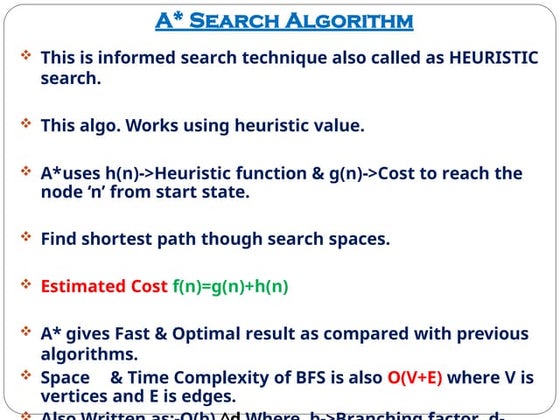



A Star Algorithm in Artificial intelligencevipulkondekar
Ėý
A Star Algorithm in Artificial intelligenceDefining the Future of Biophilic Design in Crete.pdf



Defining the Future of Biophilic Design in Crete.pdfARENCOS
Ėý
Biophilic design is emerging as a key approach to enhancing well-being by integrating natural elements into residential architecture. In Crete, where the landscape is rich with breathtaking sea views, lush olive groves, and dramatic mountains, biophilic design principles can be seamlessly incorporated to create healthier, more harmonious living environments.
Renewable-Energy-Powering-Mozambiques-Economic-Growth.pptx



Renewable-Energy-Powering-Mozambiques-Economic-Growth.pptxRofino Licuco
Ėý
Mozambique, a country with vast natural resources and immense potential, nevertheless faces several economic challenges, including high unemployment, limited access to energy, and an unstable power supply. Underdeveloped infrastructure has slowed the growth of industry and hampered peopleâs entrepreneurial ambitions, leaving many regions in the darkâliterally and figuratively.
https://www.rofinolicuco.net/blog/how-renewable-energy-can-help-mozambique-grow-its-economy04TypeCurves.pptx
- 1. ESS 454 Hydrogeology Module 4 Flow to Wells âĒ Preliminaries, Radial Flow and Well Function âĒ Non-dimensional Variables, Theis âTypeâ curve, and Cooper-Jacob Analysis âĒ Aquifer boundaries, Recharge, Thiem equation âĒ Other âTypeâ curves âĒ Well Testing âĒ Last Comments Instructor: Michael Brown brown@ess.washington.edu
- 2. Learning Objectives ï§ Forward problem: Understand how to use the Hantush- Jacob formula to predict properties of a confined aquifer with leakage ï§ Inverse problem: Understand how to use Type curves for a leaky confined aquifer to determine T, S, and B ï§ Understand how water flows to a well in an unconfined aquifer o Changes in the nature of flow with time o How to use Type curves
- 3. Other Type-Curves Given without Derivations 1. Leaky Confined Aquifer âĒ Hantush-Jacob Formula âĒ Appendix 3 of Fetter ho -h = Q 4pT W(u,r B) B = Tb' K ' âType Curvesâ to determine T, S, and r/B Drawdown reaches âsteady-stateâ when recharge balances flow Larger r/B -> smaller steady-state drawdown Same curve matching exercise as with Theis Type-curves New dimensionless number Large Kâ makes r/B large
- 4. Other Type-curves â Given without Derivations 2. Unconfined Aquifer âĒ Neuman Formula âĒ Appendix 6 of Fetter ho -h = Q 4pT W(uA,uB,G) G = r2 Kv b2 Kh uA = r2 S 4Tt uB = r2 Sy 4Tt Similar to Theis but more complicated: 1. Initial flow from elastic storage - S 2. Late time flow from gravity draining â Sy âĒ Remember: Sy>>S 3. Vertical and horizontal flow â âĒ Kv may differ from Kh Three non-dimensional variables Initial flow from Storativity Later flow from gravity draining Difference between vertical and horizontal conductivity is important
- 5. Flow in Unconfined Aquifer surface Flow from elastic storage Vertical flow (gravity draining) Horizontal flow induced by gradient in head 1. Elastic Storage Time order 2. Flow from gravity draining and horizontal head gradient Start Pumping
- 6. Other Type-curves â Given without Derivations Two-step curve matching: 1. Fit early time data to A- type curves 2. Fit late time data to B- type curves 2. Unconfined Aquifer âĒ Neuman Formula âĒ Appendix 6 of Fetter Theis curve using Elastic Storage Theis curve using Specific Yield Transition depends on ratio r2Kv/(Khb2) Sy=104*S Sy=103*S
- 7. The End: Other Type Curves Coming up: Well Testing


























